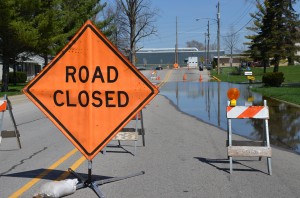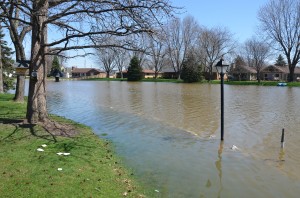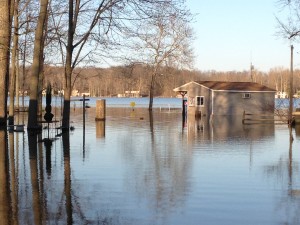River Debris Largely Blamed For Flooding

Sunset Drive, along Pike Lake Canal, was one of the many roads inaccessible after flooding caused from heavy rainfall that began on April 17.
(Photo by Alyssa Richardson)
After nearly five days of dealing with flooded roadways, lakes, yards and fields an end may be in sight.
Although the National Weather Service projects an 80 percent chance of rain late today, according to Kosciusko County Emergency Management Director Ed Rock, the National Weather Service’s Hydraulic Maps indicates flood conditions in the county are maintained and will not be worsening.
Though this comes as a relief to many who have watched water levels rise around their homes, some homeowners say this is an ongoing and unrelenting problem.
Linda Berger, a resident of Sunset Drive, a street flooded by rising waters from the Pike Lake channels every few years, says the flooding around her neighborhood pales in comparison to previous years. Berger states that for many in the neighborhood, dealing with water levels that rise up to their back doors is something many have had to accept.

Linda Berger, a resident of Sunset Drive, states that the flooding of the canal happens frequently for residents of the neighborhood. Bergers stone wall and light post that usually lines the walkway to the canal can be seen here, fully engulfed in water.
(photo by Alyssa Richardson)
This continual flooding is attributed to a buildup of debris from the Tippecanoe River throughout its 30-mile stretch between Oswego Lake to the Kosciusko County line. According to Grace College Environmental Science Professor and Director of Kosciusko Lakes and Streams Dr. Nate Bosch, the current situation is related to the flow of the Tippecanoe River through Kosciusko County.
Bosch says the river is currently constricted in over 100 locations along the 30-mile stretch from debris like downed trees. For areas like Pike Lake that flow into the Tippecanoe River, the debris blockage downstream causes the water to back up much like a clogged drain.
“We are currently raising local funds to clean out the river and getting it flowing more efficiently and naturally,” says Bosch. “Interested individuals or businesses can make a donation designated to Kosciusko Lakes and Streams at the Grace College giving page.”
Though preliminary estimates for this cleanup project total over $130,000, efforts to begin clean up are underway. Rock says a project to clean debris out of the Tippecanoe River has begun to develop thanks to a grant given by the Indiana Department of Natural Resources. Though the grant does provide assistance in raising the necessary funds, Rock notes it also requires a 20 percent match that has led to a search for donors.

Jellyston Park, photographed above, is located on Ridlinger Lake, which was among the local lakes to overflow.
(Photo by Curtis Smeltzer)
Thus far, Rock reports 60 percent of the necessary matched funds have been raised, however, it wont be enough to fix all of the problems associated with the river. Instead, Rock explains that the county will have to decide on one of two approaches to fix some of the problems at hand.
The first solution, according to Rock, would be to begin the necessary work at the southwest county Marshall County and Kosciusko County line and work backward. The second approach, and what Rock states he believes will be solution chosen, would require the largest blockages between Oswego and the west county line to be serviced first. Once funds have been raised and a decision has been made on how to deal with the blockages, Rock says the project will begin seeking bids from contractors.
Those interested in providing a donation to assist with the clearing of debris in the Tippecanoe River may click HERE.
Water on the Barbee Chain of Lakes continues to rise today, which prompted the Indiana Department of Natural Resources to issue an order that motorboats must operate only at idle speed on any of the lakes. To see water levels in real time, the U.S. Geological Survey maintains two stream gauges on the Tippecanoe River in Kosciusko County. Click HERE to see the current water level and stream flow at the outlet of Lake TIppecanoe in Oswego.
For information on how you may report damages caused by severe weather and flooding that began April 17 click here. A link to the form is also available on the Indiana Department of Homeland Security website. In the middle of the page under “Featured Topics,” click on “Report Damage From Severe Storms and Flooding – April 17-22, 2013.”
Individuals will be asked to provide their name, address, phone number and type of damage the property sustained. Losses can include structural damage to homes and loss of personal property.
